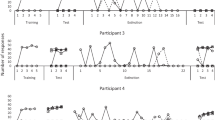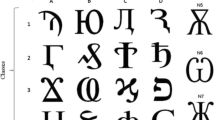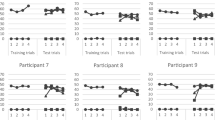Abstract
The present study compared the direct and derived extinction of avoidance responses in equivalence classes. Two classes with four abstract figures in each class (Class 1: A1-B1-C1-D1; Class 2: A2-B2-C2-D2) were first established. An avoidance response that was trained in the presence of one stimulus (B1) was emitted under control of the other stimuli from the same class (C1 and D1). The subjects were then assigned to two different groups (Direct Extinction Group and Derived Extinction Group). Different extinction procedures were implemented for each group. In the Direct Extinction Group, B1 was presented in extinction. In the Derived Extinction Group, C1 was presented in extinction. Finally, the transfer of extinction was evaluated in the presence of the other stimuli from each class. In the Direct Extinction Group, avoidance responses were extinguished for 4 of the 16 participants in the presence of B1. In the Derived Extinction Group, avoidance responses were extinguished for 10 of the 16 participants in the presence of C1. The results indicated that derived extinction occurred more easily than direct extinction. Considering that avoidance responses were extinguished only for a few participants, future studies should implement more efficient procedures to establish avoidance extinction and then evaluate possible differences between derived and direct extinction in the transfer of extinction.
Similar content being viewed by others
Availability of Data and Materials
The manuscript includes all relevant data supporting the findings. Additional data may be provided upon request to the corresponding author.
Notes
t32 could not be calculated because the standard deviation of both groups is zero.
The International Affective Picture System (Lang, Bradley, & Cuthbert, 2008) and International Affective Digitized Sounds (Bradley & Lang, 2007) provide sets of standardized stimuli (images and sounds, respectively) that can be used to induce different emotional states in experimental subjects in the laboratory.
References
Assaz, D. A., Roche, B., Kanter, J. W., & Oshiro, C. K. B. (2018). Cognitive defusion in Acceptance and Commitment Therapy: What are the basic processes of change? Psychological Record, 68(4), 405–418. https://doi.org/10.1007/s40732-017-0254-z.
Augustson, E. M., & Dougher, M. J. (1997). The transfer of avoidance evoking functions through stimulus equivalence classes. Journal of Behavior Therapy & Experimental Psychiatry, 28(3), 181–191. https://doi.org/10.1016/S0005-7916(97)00008-6.
Augustson, E. M., Dougher, M. J., & Markham, M. R. (2000). Emergence of conditional stimulus relations and transfer of respondent eliciting functions among compound stimuli. The Psychological Record, 50, 745–770. https://doi.org/10.1007/BF03395381.
Baum, M. (1973). Extinction of avoidance behavior: Comparison of various flooding procedures in rats. Bulletin of the Psychonomic Society, 1(1), 22–24. https://doi.org/10.3758/BF03333326.
Bennett, M., Hermans, D., Dymond, S., Vervoort, E., & Baeyens, F. (2015). From bad to worse: Symbolic equivalence and opposition in fear generalisation. Cognition & Emotion, 29(6), 1137–1145. https://doi.org/10.1080/02699931.2014.973833.
Boldrin, L. S., & Debert, P. (2017a). Avoidance Software (Versão 1.0) [Computer Software]. São Paulo, Brazil: Instituto de Psicologia da Universidade de São Paulo.
Boldrin, L. S., & Debert, P. (2017b). Matching to Sample Procedure Software (Versão 1.0) [Computer Software]. São Paulo, Brazil: Instituto de Psicologia da Universidade de São Paulo.
Boyle, S., Roche, B., Dymond, S., & Hermans, D. (2016). Generalisation of fear and avoidance along a semantic continuum. Cognition & Emotion, 30(2), 340–352. https://doi.org/10.1080/02699931.2014.1000831.
Bradley, M. M., & Lang, P. J. (2007). The International Affective Digitized Sounds ( IADS-2): Affective ratings of sounds and instruction manual (2nd ed.). University of Florida, Gainesville, FL.
de Rose, J. C., McIlvane, W. J., Dube, W. V., Galpin, V. C., & Stoddard, L. T. (1988). Emergent simple discrimination established by indirect relation to differential consequences. Journal of the Experimental Analysis of Behavior, 50(1), 1–20. https://doi.org/10.1901/jeab.1988.50-1.
Dougher, M. J., Augustson, E., Markham, M. R., Greenway, D. E., & Wulfert, E. (1994). The transfer of respondent eliciting and extinction functions through stimulus equivalence classes. Journal of the Experimental Analysis of Behavior, 62(3), 331–351. https://doi.org/10.1901/jeab.1994.62-331.
Dougher, M. J., Hamilton, D. A., Fink, B. C., & Harrington, J. (2007). Transformation of the discriminative and eliciting functions of generalized relational stimuli. Journal of the Experimental Analysis of Behavior, 88(2), 179–197. https://doi.org/10.1901/JEAB.2007.45-05.
Dua, J. K. (1979). Comparative effectiveness of flooding and response prevention in the extinction of human fear and avoidance responding. Australian Journal of Psychology, 31(1), 33–42. https://doi.org/10.1080/00049537908254647.
Dymond, S., & Barnes, D. (1995). A transformation of self-discrimination response functions in accordance with the arbitrarily applicable relations of sameness, more than, and less than. Journal of the Experimental Analysis of Behavior, 64(2), 163–184. https://doi.org/10.1901/JEAB.1995.64-163.
Dymond, S., & Barnes, D. (1996). A transformation of self-discrimination response functions in accordance with the arbitrarily applicable relations of sameness and opposition. The Psychological Record, 46(2), 271–301.
Dymond, S., & Roche, B. (2009). A contemporary behavior analysis of anxiety and avoidance. The Behavior Analyst, 32(1), 7–27. https://doi.org/10.1007/BF03392173.
Dymond, S., Roche, B., Forsyth, J. P., Whelan, R., & Rhoden, J. (2007). Transformation of avoidance response functions in accordance with same and opposite relational frames. Journal of the Experimental Analysis of Behavior, 88(2), 249–262. https://doi.org/10.1901/jeab.2007.22-07.
Dymond, S., Schlund, M. W., Roche, B., Whelan, R., Richards, J., & Davies, C. (2011). Inferred threat and safety: Symbolic generalization of human avoidance learning. Behaviour Research & Therapy, 49(10), 614–621. https://doi.org/10.1016/J.BRAT.2011.06.007.
Dymond, S., Schlund, M. W., Roche, B., & Whelan, R. (2014). The spread of fear: Symbolic generalization mediates graded threat-avoidance in specific phobia. Quarterly Journal of Experimental Psychology, 67(2), 247–259. https://doi.org/10.1080/17470218.2013.800124.
Dymond, S., Dunsmoor, J. E., Vervliet, B., Roche, B., & Hermans, D. (2015). Fear generalization in humans: Systematic review and implications for anxiety disorder research. Behavior Therapy, 46(5), 561–582. https://doi.org/10.1016/j.beth.2014.10.001.
Dymond, S., Bennett, M., Boyle, S., Roche, B., & Schlund, M. (2018). Related to anxiety: Arbitrarily applicable relational responding and experimental psychopathology research on fear and avoidance. Perspectives on Behavior Science, 41(1), 189–213. https://doi.org/10.1007/s40614-017-0133-6.
Gandarela, L., Boldrin, L. S., & Debert, P. (2020). Transfer of the avoidance function in equivalence classes using loss of points as the aversive stimulus. The Psychological Record. https://doi.org/10.1007/s40732-019-00365-2.
Gannon, S., Roche, B., Kanter, J. W., Forsyth, J. P., & Linehan, C. (2011). A derived relations analysis of approach-avoidance conflict: Implications for the behavioral analysis of human anxiety. The Psychological Record, 61(2), 227–252. https://doi.org/10.1007/BF03395758.
Garcia-Guerrero, S., Dickins, T. E., & Dickins, D. W. (2014). The gradual extinction of transferred avoidance stimulus functions. The Psychological Record, 64(3), 581–599. https://doi.org/10.1007/s40732-014-0062-7.
Guinther, P. M., & Dougher, M. J. (2015). The clinical relevance of stimulus equivalence and relational frame theory in influencing the behavior of verbally competent adults. Current Opinion in Psychology, 2, 21–25. https://doi.org/10.1016/J.COPSYC.2015.01.015.
Hayes, S. C., Barnes-Holmes, D., & Roche, B. T. (2001). Relational frame theory: A Post-Skinnerian account of human language and cognition. New York, NY: Plenum Press.
Lang, P. J., Bradley, M. M., & Cuthbert, B. N. (2008). International affective picture system (IAPS): Affective ratings of pictures and instruction manual. Gainesville, FL: University of Florida.
Markham, M. R., Dougher, M. J., & Augustson, E. M. (2002). Transfer of operant discrimination and respondent elicitation via emergent relations of compound stimuli. The Psychological Record, 52(3), 325–350. https://doi.org/10.1007/BF03395434.
Roche, B. T., Kanter, J. W., Brown, K. R., Dymond, S., & Fogarty, C. C. (2008). A comparison of “direct” versus “derived” extinction of avoidance responding. The Psychological Record, 58(3), 443–464. https://doi.org/10.1007/BF03395628.
Sidman, M. (1994). Equivalence relations and behavior: A research story. Boston, MA: Authors Cooperative.
Valverde, M. R., Luciano, C., & Barnes-Holmes, D. (2009). Transfer of aversive respondent elicitation in accordance with equivalence relations. Journal of the Experimental Analysis of Behavior, 92(1), 85–111. https://doi.org/10.1901/jeab.2009.92-85.
Vervoort, E., Vervliet, B., Bennett, M., & Baeyens, F. (2014). Generalization of human fear acquisition and extinction within a novel arbitrary stimulus category. PLOS ONE, 9(5), e96569. https://doi.org/10.1371/JOURNAL.PONE.0096569.
Author information
Authors and Affiliations
Corresponding author
Ethics declarations
Conflict of Interest
The authors declare that they have no conflicts of interest.
Ethical Approval
All the procedures performed in the studies involving human participants were in accordance with the ethical standards of the institutional and/or national research committee, and with the 1964 Helsinki declaration and its later amendments or comparable ethical standards.
Informed Consent
Informed consent was obtained from all individual participants included in the study.
Additional information
Publisher’s Note
Springer Nature remains neutral with regard to jurisdictional claims in published maps and institutional affiliations.
Leandro S. Boldrin is supported by the Conselho Nacional de Desenvolvimento Científico e Tecnológico (149766/2018-1). Paula Debert is affiliated with the Instituto Nacional de Ciência e Tecnologia sobre Comportamento, Cognição e Ensino – INCT-ECCE, supported by FAPESP (2014/5990-8) and CNPq (465686/2014-1).
Rights and permissions
About this article
Cite this article
Boldrin, L.S., Debert, P. Direct and Derived Extinction of Avoidance Responses in Equivalence Classes. Psychol Rec 70, 433–444 (2020). https://doi.org/10.1007/s40732-020-00419-w
Published:
Issue Date:
DOI: https://doi.org/10.1007/s40732-020-00419-w




